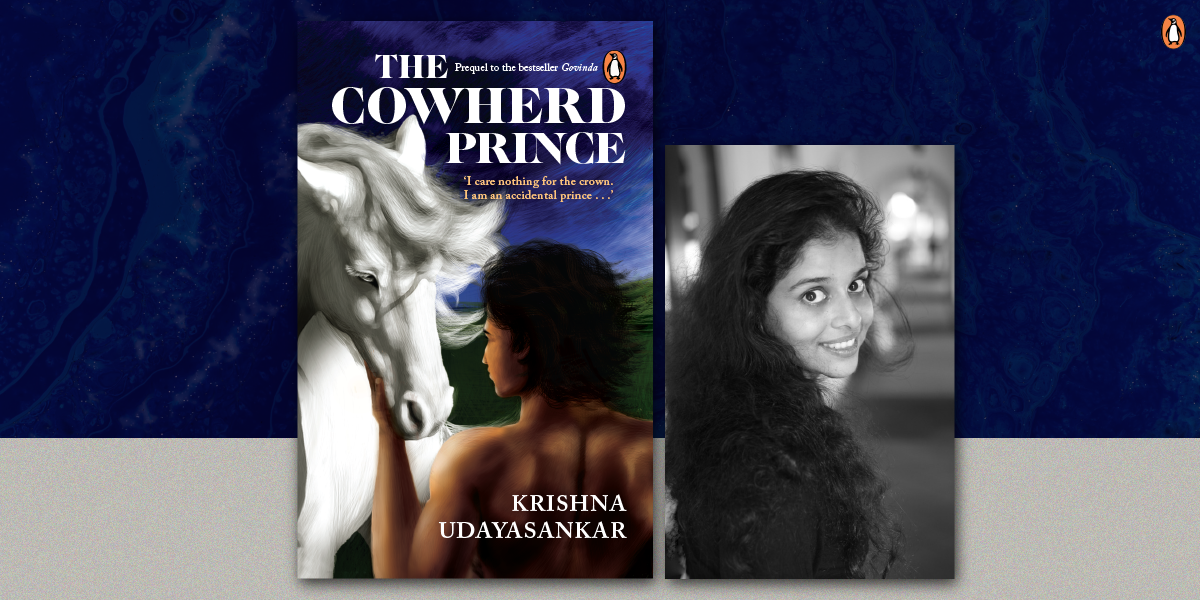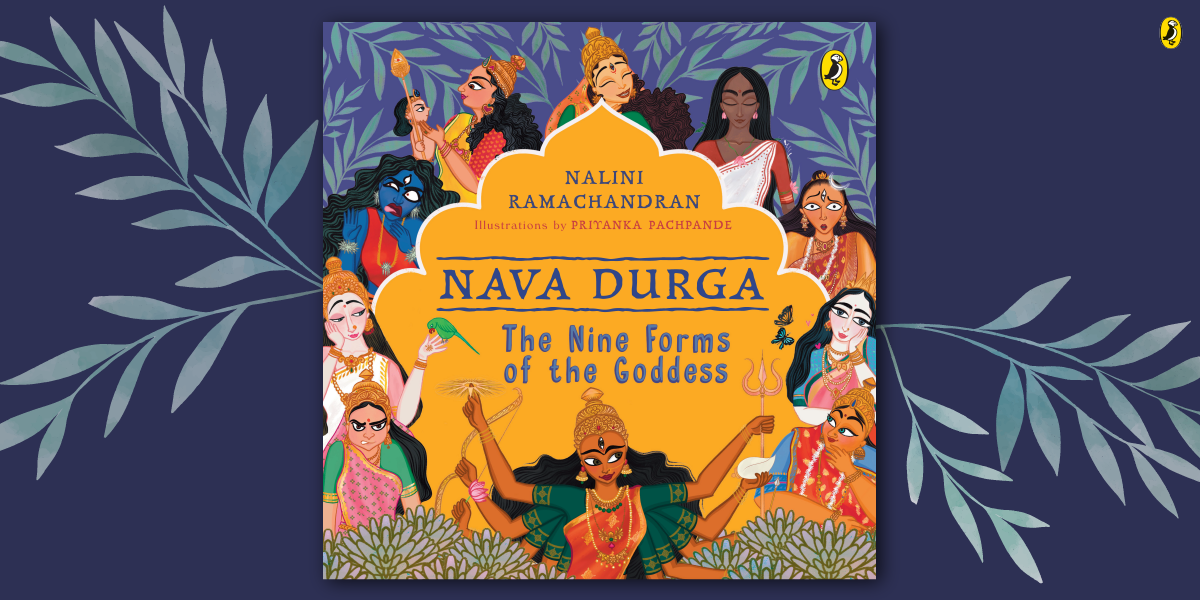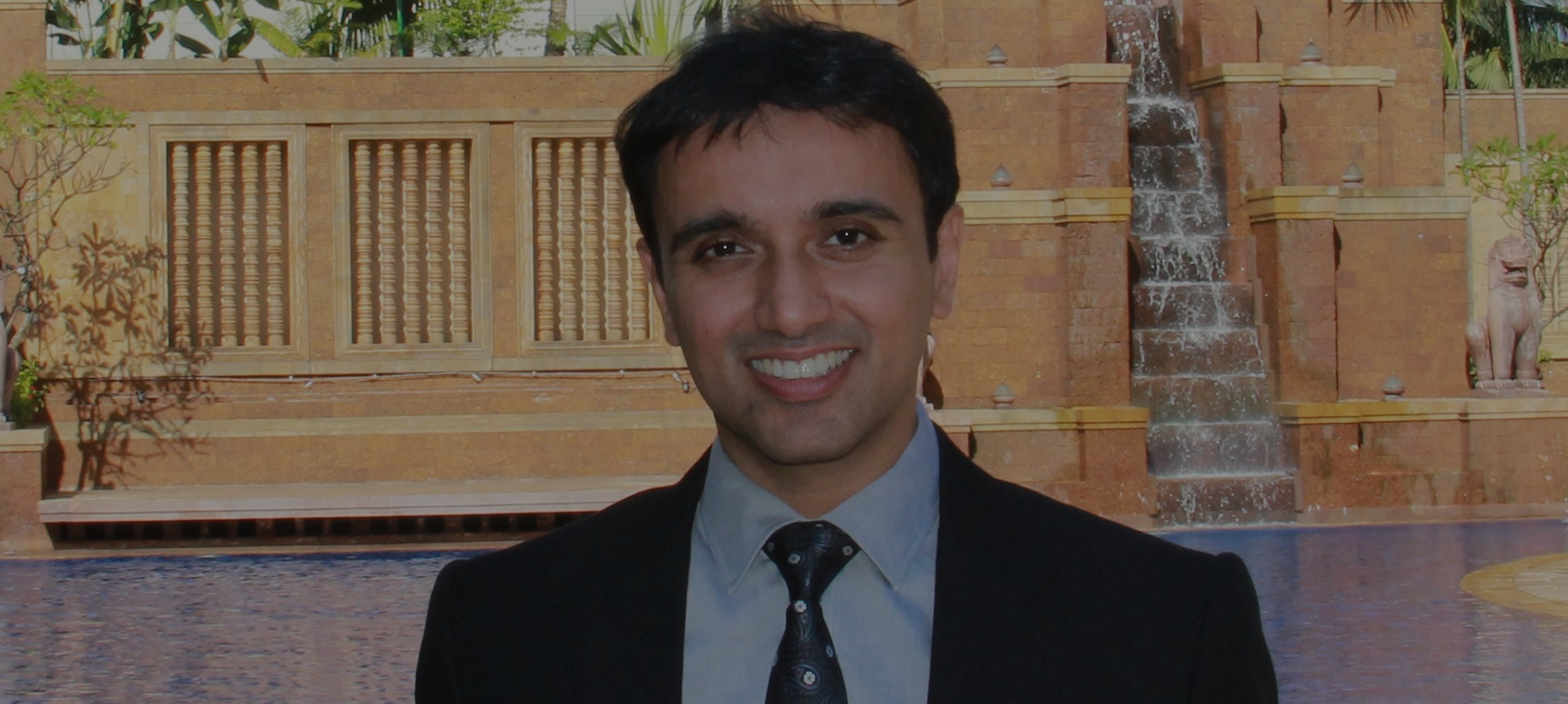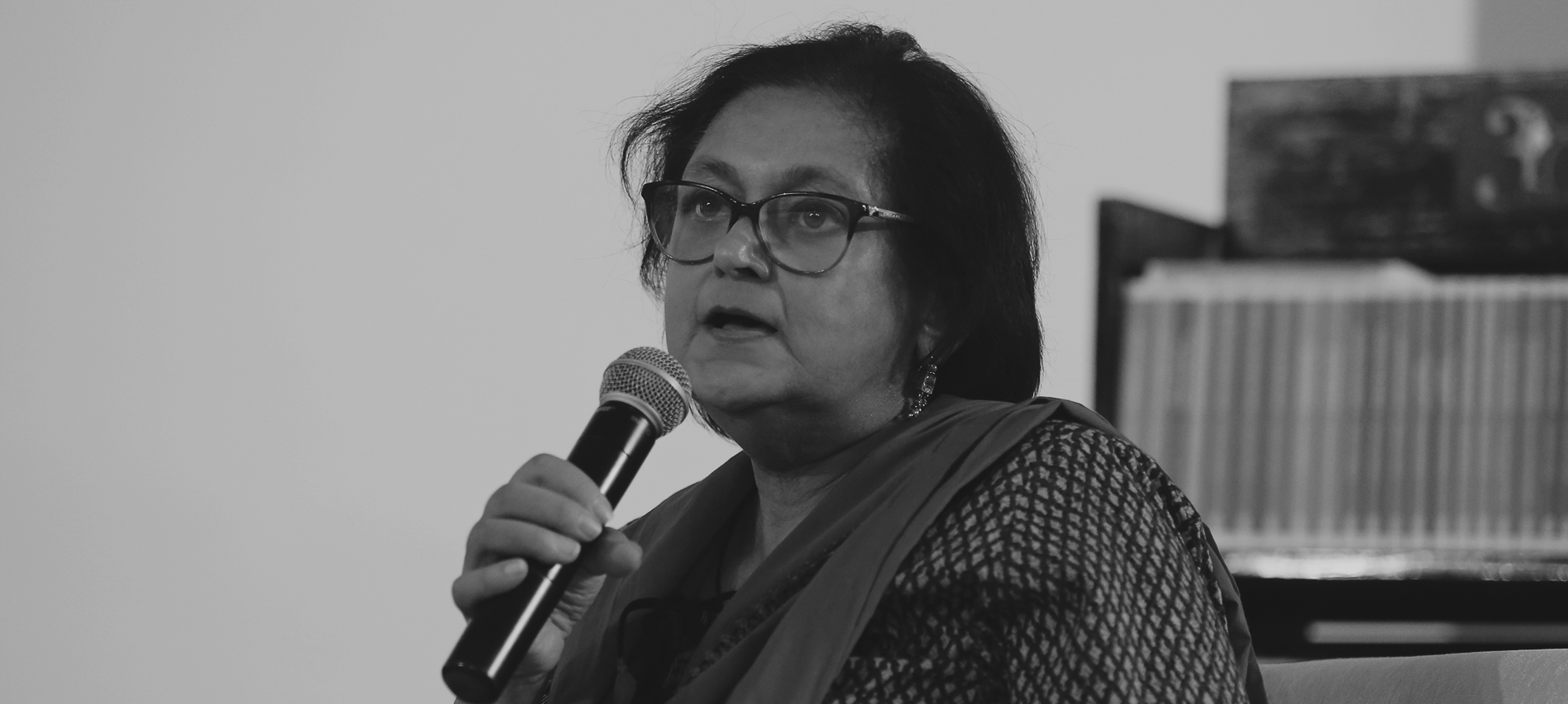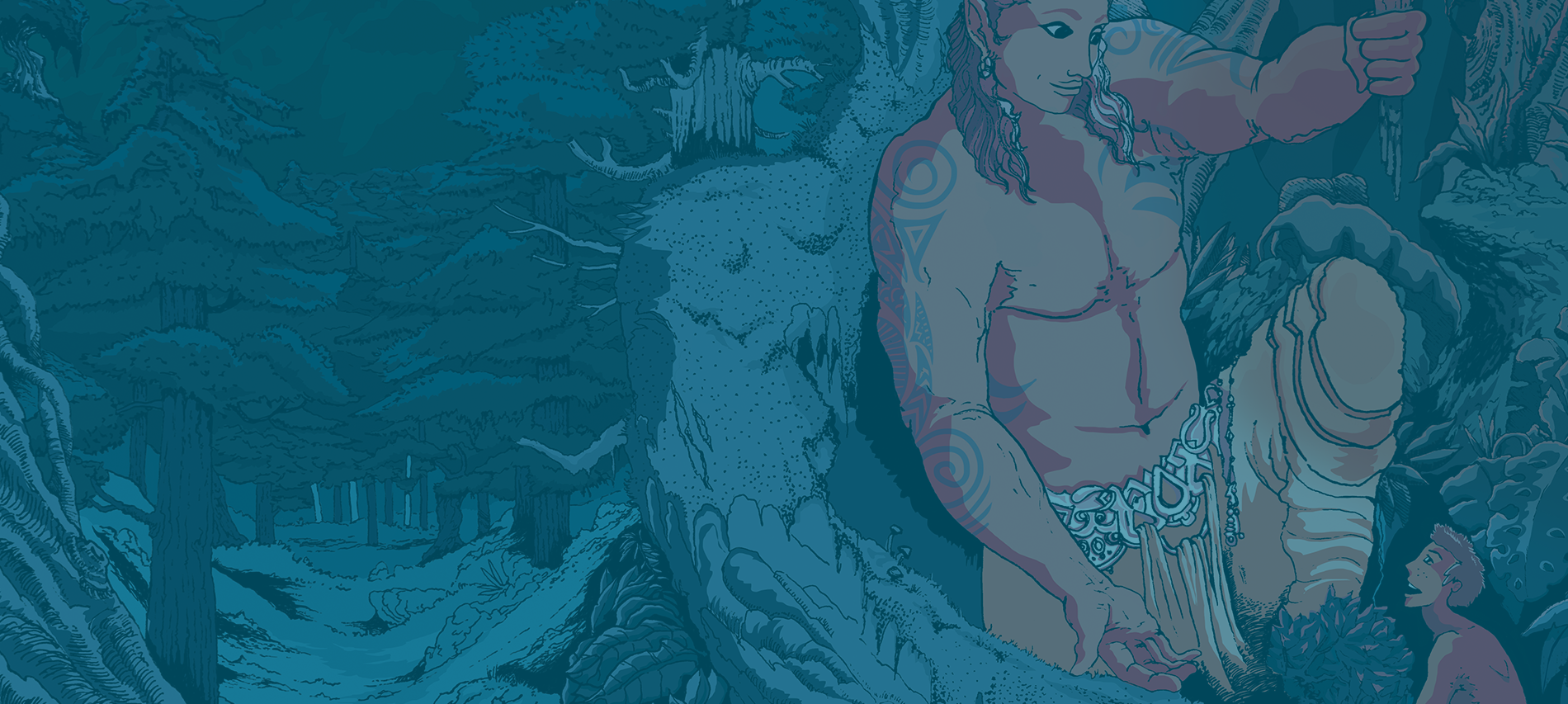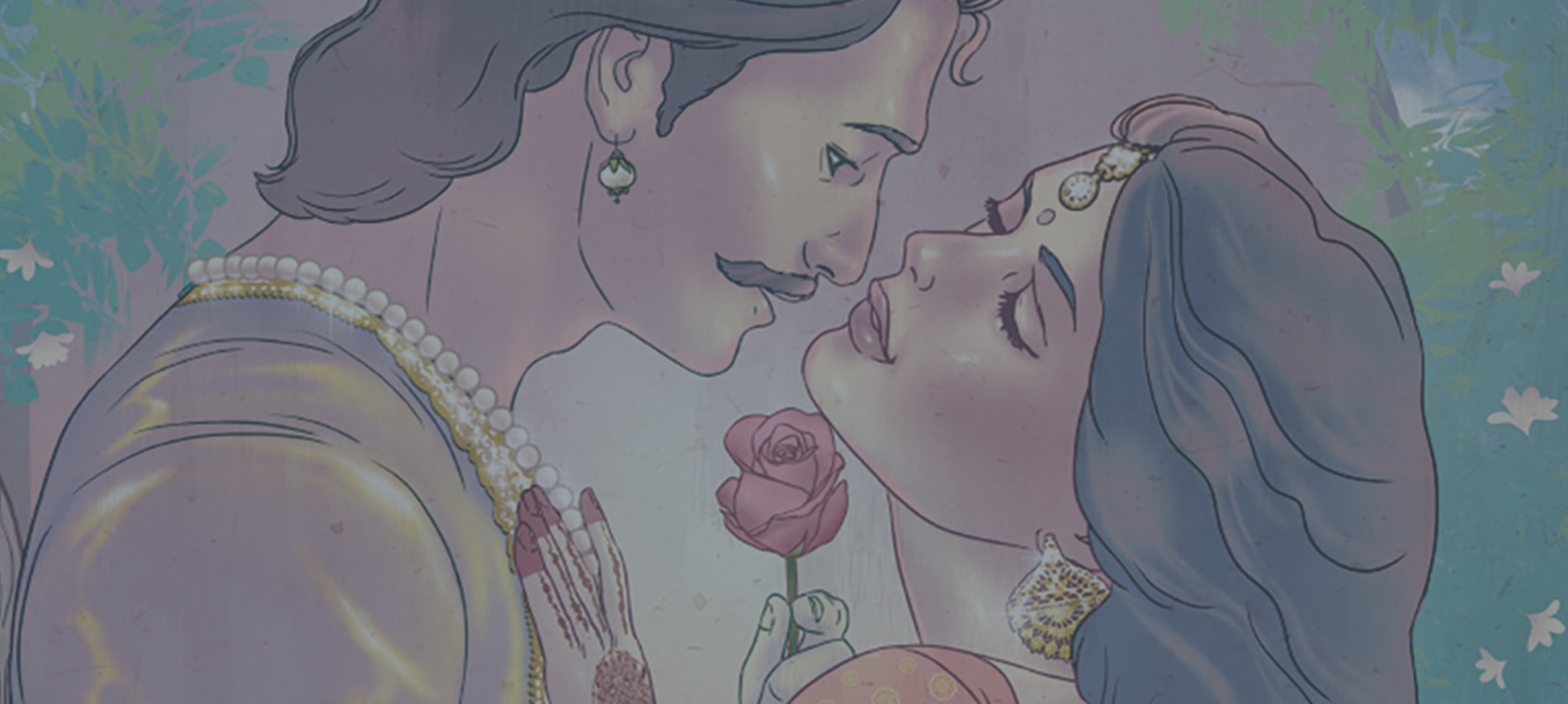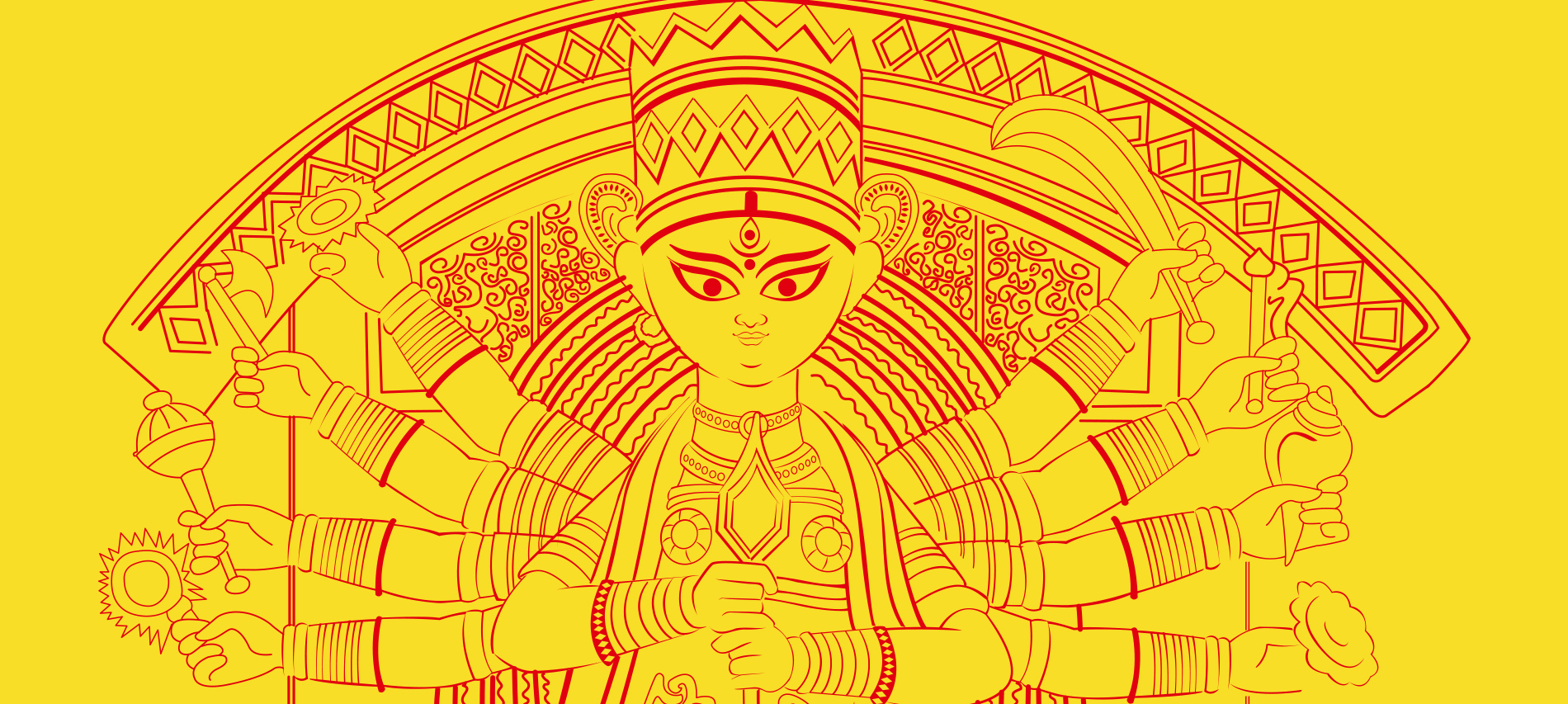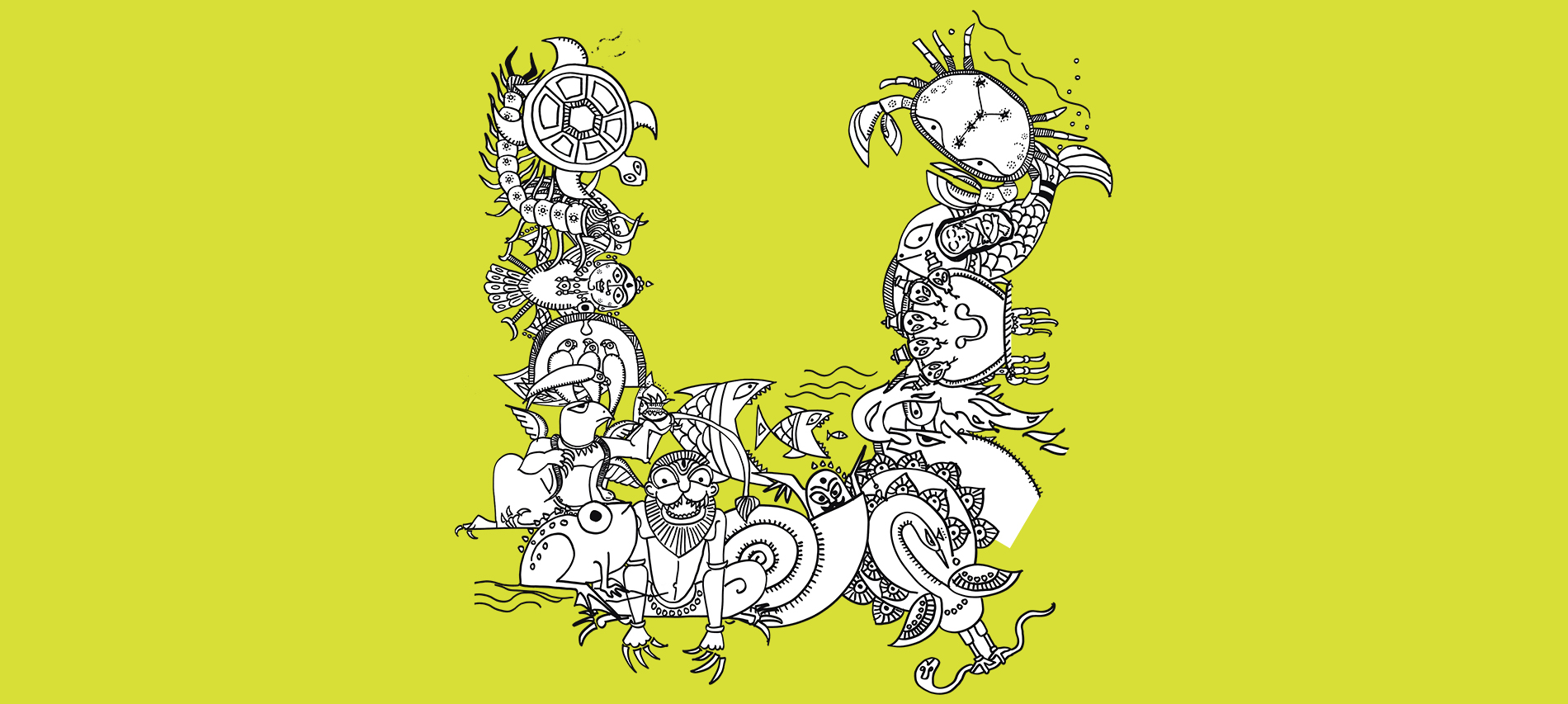While many use religion to justify why they are being unfair to a person’s gender and sexuality, Devdutt Pattanaik in his books The Pregnant King and Shikhandi And Other Queer Tales They Don’t Tell You shows how mythologies across the world appreciate what we deem as queer.
Here are 6 quotes on what it means to be a man, a woman, or a queer.
What it feels to be a woman

Repercussion of Patriarchy

The meaning of queer in different mythologies

Should the queer hide or be heard like the thunderous clap of the hijra?

The functions of the forms

Traces of feminism in Hindu mythology

Read Devdutt Pattanaik’s The Pregnant King and Shikhandi And Other Queer Tales They Don’t Tell You and make sense of queerness and the diversity in society.
Tag: Indian Mythology
Up close with Krishna Udayasankar
If you just cannot get enough of The Cowherd Prince, you are not alone. Krishna Udayasankar’s prequel to the bestselling novel Govinda is a thrilling insight into the world of Govinda before he became the master strategist of The Mahabharata. We had a chat with the author and it was an absolute delight!
~
We hear you’re a science fiction buff. Who are your favourite writers in the genre?
KU: I was a huge fan of Isaac Asimov as a child and teenager. I mean, I still am, but it’s difficult to say that now without asking myself questions about separating the art from the artist – after the allegations of harassment against Asimov. But I can’t stop liking what I’ve liked all these years, I can’t change the fact that I love the books and have been influenced greatly by them. So yes…
You characterise your protagonist Govinda very carefully. You have also said that consent is one of the most important things to learn from Govinda. What would you say is the importance of looking at mythological characters from a more contemporary lens?
KU: Fiction is a device by which we look at the world around us, all the more so for genres that deal with alternate worlds, like myth and history or fantasy. In fact, I’d go so far as to say that good fiction is always a commentary on the way the world is. When it comes to mythology, I believe that becomes even more important because it is a two-way thing – the way we understand our past, the way we believe things happened, are fundamental parts of how society functions in the present. And if we want to question our present or examine it, then we also need to examine our understanding of myth or the pre-historic past – all the more so because for a large part of our society, myth is the bedrock of defining good and bad, right and wrong.
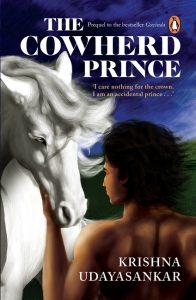
We also hear that you hate spinach. If abandoned on a deserted island with only spinach to eat, which three books would you take with you?
KU: Haha! Since I would not eat a book or tear it up even if I were starving, I assume the question is which books can make the spinach go down easier? Traditionally, it would be Amar Chitra Kathas – since those were the spinach-y books of my childhood. But now my list would be: My entire Calvin and Hobbes collection, Kalki’s Ponniyin Selvan and Asimov’s Foundation series. And maybe I’d try to sneak in Lord of the Rings too? And The Jungle Book. And … wait a minute, three books? I can survive on spinach but I can’t survive on only three books.
What are you reading now? What book are you excited to read next?
KU: I am re-reading Martha Well’s Murderbot novellas in anticipation of reading her latest – a full Murderbot novel next.
What is your favourite thing about being a writer?
KU: Hanging out with some amazing (imaginary) people. Living in other worlds. Travelling to places I have never been, vicariously doing things I can’t dream of doing otherwise in this lifetime (whether it’s flying a fighter jet or whipping up a six-course meal!) And of course, one of the best parts of being a writer is getting to share these experiences with readers – who often become friends.
How do you battle writer’s block?
KU: I don’t battle it, not anymore! All I do is show up every day, even if that means I’m doing nothing other than stare at a blank page. But that is when I am writing. I often go for months without writing, particularly between books. I’ve learnt that imagining new worlds, new stories is one of the best parts of writing (other than playing with words). I tell myself now, that its ok to do that, and the story will come to me when it has to.
What is your writing process like? Are you a planner, or do you wing it, or is there a third customized method that works for you?
KU: I’m a mix of planned, chaotic and downright clueless. I think I try different methods at different points on time in a book – usually winging it when I begin, then stepping back to plan a little bit, then just being instinctive about it again. I also work on multiple books, sometimes, so I could be following different processes at once. Like I said, clueless and chaotic!
~
Krishna Udayasankar’s The Cowherd Prince is captivating and will keep you reading well into the early hours of the morning.
Ashta Siddhis and the extraordinary powers of Goddess Durga
Do you know what the Ashta Siddhis, or the eight kinds of supernatural powers are? Read an excerpt to find out more about Nalini Ramachandran’s Nava Durga and the extraordinary powers that Goddess Durga can bestow on other gods!
~
The goddess, in each of her forms, grants different kinds of blessings to her devotees. But Siddhidatri, the goddess worshipped on the ninth day of Navaratri, is special. In Sanskrit, ‘siddhi’ means ‘supernatural power’ and datri means ‘giver’. So, Siddhidatri is ‘the giver of supernatural powers’.
After Adi Shakti, in the form of Kushmanda, had created the universe and the new gods and goddesses, Shiva prayed to her, ‘O Supreme Goddess, grant me all the siddhis to make me a perfect god.’
He meditated for thousands of years so that Adi Shakti would listen to him. Impressed by Shiva’s devotion, the goddess appeared in the avatar of Siddhidatri from Kushmanda’s japa mala, which the smiling goddess used to bless people with the ashta siddhis and the nava niddhis. Almost immediately, Siddhidatri also emerged from the left side of Shiva’s body. So the right half of Shiva’s body was his own, and the left half was in the form of Siddhidatri. This half-man, half-woman form of Shiva is known as Ardhanarishwara, ‘the lord who is half woman’.
Just as she lives within humans, she began living within Shiva too as his shakti. And in this unique way, she bestowed supernatural powers on him and made him a perfect god.
…Those who truly worship Siddhidatri can get some or all of these abilities (but it’s easier said than done!):
Mahima
To make your body huge in size
(It can help when you suddenly come face to face with a mighty asura.)
Anima

To make your body as tiny as an atom
(It can help when you play hide-and-seek with friends.)
Garima
To become very, very heavy
(You can face a storm like a mountain.)
Laghima
To be nearly weightless
(You can levitate or even float in the air.)
Prapti
To travel to or be present in any place you wish
(You can time-travel, whenever and wherever you want.)
Prakamya
To get or be able to give whatever one desires
(You can gift your mother the very thing she has been secretly wishing for!)
Ishitva
To be in control of nature, like a god
(You can make the sun listen to you in summer and make the rain obey you in monsoon.)
Vashitva
To be able to control other beings.
(You can turn bullies into friends.)
~
Nalini Ramachandran’s Nava Durga tells us about the rich mythology of Durga Puja and what makes each day special!
Tales as old as time: Mythological reads for you!
This month, we have been revisiting tales as old as time from the immersive world of Indian mythology and our favourite epics!
Scroll down to have a look at our reading list and join us on this journey!
The Aryavarta Chronicles
Govinda: The Aryavarta Chronicles Book 1
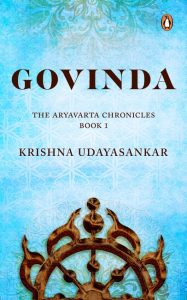
For generations, the Firstborn dynasty of scholar-sages, descendants of Vasishta Varuni and protectors of the Divine Order on earth, has dominated here. For just as long, the Angirasa family of Firewrights, weapon-makers to the kings and master inventors, has defied them. In the aftermath of the centuries-long conflict between the two orders, the once-united empire of Aryavarta lies splintered, a shadow of its former glorious self.
Kaurava: The Aryavarta Chronicles Book 2

Emperor Dharma Yudhisthir of the Kauravas and Empress Panchali Draupadi rule over a unified Aryavarta, an empire built for them by Govinda Shauri with the blessings of the Firstborn and by the might of those whom everyone believes long gone – the Firewrights.
Now the Firewrights rise from the ashes of the past, divided as before in purpose and allegiance, and no one,
His every dream shattered, Govinda is left a broken man. The only way he can protect Aryavarta and the woman in whose trusted hands he had left it is by playing a dangerous game. But can he bring himself to reveal the terrible secrets that the Vyasa has guarded all his life – secrets that may well destroy the Firstborn, and the Firewrights with them?
Kurukshetra: The Aryavarta Chronicles Book 3

The empire that was Aryavarta fades under the shadow of doom. As the bitter struggle to gain control of the divided kingdom ensues, both Krishna Dwaipayana Vyasa of the Firstborn and the Secret Keeper of the Firewrights can only watch as their own blood, their kin, savage and kill on the fields of Kurukshetra. Restraint and reason have deserted the rulers who once protected the land and they manipulate, scheme and kill with abandon – for victory is all that matters.
Reforging the forsaken realm in the fire of his apocalyptic wrath, Govinda prepares to destroy everything he loves and make the ultimate sacrifice for the sake of one last hope: that humanity will rise.
**
Vanara: The Legend of Baali, Sugreeva and Tara
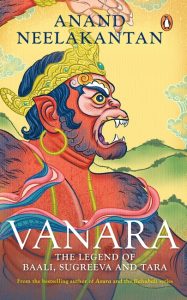
Baali and Sugreeva of the Vana Nara tribe were orphan brothers who were born in abject poverty and grew up as slaves like most of their fellow tribesmen. They were often mocked as the vanaras, the monkey men. Sandwiched between the never-ending war between the Deva tribes in the north and the Asura tribes in the south, the Vana Naras seemed to have lost all hope. But Baali was determined not to die a slave. Aided by his beloved brother, Sugreeva, Baali built a country for his people.
The love triangle between Baali, Tara and Sugreeva is arguably the world’s first.
Vanara is a classic tale of love, lust and betrayal. Shakespearean in its tragic depth and epic in its sweep, Vanara gives voice to the greatest warrior in the Ramayana-Baali.
**
The Mahabharata (Box Set)

The greatest Indian story ever told of a war between two factions of a family, The Mahabharata has continued to sway the imagination of its readers over the past centuries.
While the dispute over land and kingdom between the warring cousins-the Pandavas and the Kauravas-forms the chief narrative, the primary concern of The Mahabharata is about the conflict of dharma. These conflicts are immense and various, singular and commonplace.
The complete and unabridged Sanskrit classic, now masterfully and accessibly rendered for contemporary readers by Bibek Debroy.
**
Ramayana, Mahabharata, Bhagvata: Illustrated Retellings of the Greatest Indian Epics Box Set
Jaya: An Illustrated Retelling of the Mahabharata

High above the sky stands Swarga, paradise, abode of the gods. Still above is Vaikuntha, heaven, abode of God.
The doorkeepers of Vaikuntha are the twins, Jaya and Vijaya, both whose names mean ‘victory’. One keeps you in Swarga; the other raises you into Vaikuntha. In Vaikuntha there is bliss forever, in Swarga there is pleasure for only as long as you deserve.
What is the difference between Jaya and Vijaya? Solve this puzzle and you will solve the mystery of the Mahabharata.
Sita: An Illustrated Retelling of the Ramayana
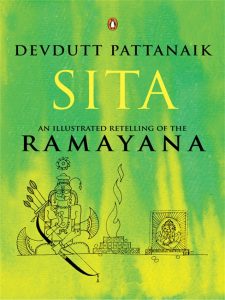
It is significant that the only character in Hindu mythology, a king at that, to be given the title of ekam-patni-vrata, devoted to a single wife, is associated with the most unjust act of abandoning her in the forest to protect family reputation.
This book approaches Ram by speculating on Sita—her childhood with her father, Janak, who hosted sages mentioned in the Upanishads; her stay in the forest with her husband who had to be a celibate ascetic while she was in the prime of her youth; her interactions with the women of Lanka, recipes she exchanged, emotions they shared; her connection with the earth, her mother; her role as the Goddess, the untamed Kali as well as the demure Gauri, in transforming the stoic prince of Ayodhya into God.
Shyam: An Illustrated Retelling of the Bhagavata
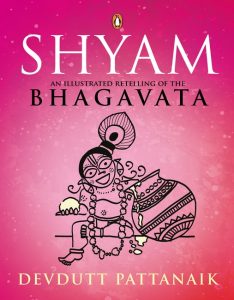
The Bhagavata is the story of Krishna, known as Shyam to those who find beauty, wisdom and love in his dark complexion. It is the third great Hindu epic after the Mahabharata and the Ramayana.
This book seamlessly weaves the story from Krishna’s birth to his death, or rather from his descent to the butter-smeared world of happy women to his ascent from the blood-soaked world of angry men.
**
Myth = Mithya
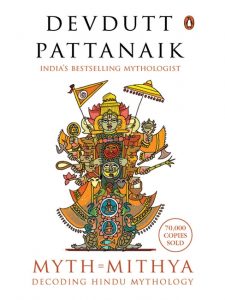
In this groundbreaking book Dr Devdutt Pattanaik; one of India’s most popular mythologists; seeks an answer to these apparent paradoxes and unravels an inherited truth about life and death; nature and culture; perfection and possibility. He retells sacred Hindu stories and decodes Hindu symbols and rituals; using a unique style of commentary; illustrations and diagrams. We discover why the villainous Kauravas went to heaven and the virtuous Pandavas (all except Yudhishtira) were sent to hell; why Rama despite abandoning the innocent Sita remains the model king; why the blood-drinking Kali is another form of the milk-giving Gauri; and why Shiva wrenched off the fifth head of Brahma.
—
Why Science & Religion may not be Adversaries
By Dr Vineet Aggarwal
When young Jagdish aka J. C. Bose, a brilliant Indian scientist extended his hand to pluck a flower, his mother admonished, him, ‘Plants were not to be disturbed at night! It’s time for them to sleep.’
As a kid, when I heard similar warnings from my grandmother, I used to laugh them away calling her superstitious. Born in pre-independence India, my grandmother was barely educated, what would she know about plants or the science associated with them? It wasn’t until I took up botany years later and learnt the concept of Nyctinasty (in lay terms, the response of plants to changes in light intensity), that I realized how deeply based on science this suggestion actually was.
The innocuous statement said to a young J. C. Bose, helped change our understanding of the plant kingdom for all time to come for it made him show the world that plants could feel pain as well as understand affection. This realization made me wonder what could happen if we look at other such myths and so called superstitious religious beliefs in the light of science. There is so much information available at the click of a button that it is almost criminal to not to explore the world around us and get to know more about it.
When I tell someone I am a doctor, most people automatically assume I would have nothing to do with religion. The perception that people into science are not into religion and vice-a-versa is quite prevalent and I know it is not without reason. These two disciplines have always been at logger heads with each other. Galileo, who quite to the chagrin of the notions of established religion, used the telescope to declare that the Sun did not after all revolve around the earth, had to kneel to the clergy and accept that his theory was false.
Charles Darwin, who first came out with the Theory of Evolution faced considerable criticism. In spite of a huge body of evidence to support his claims, most religious clerics and even many men of science refused to accept the theory in his lifetime. Even today, leaders of various religious communities keep giving diktats to their followers on what is or isn’t acceptable. Similarly, we find a lot of people educated in the modern system of schooling rubbishing religious beliefs as primitive mumbo jumbo. Of course a lot of religion is ritual but that doesn’t mean all of it is to be considered unscientific. At the same time, religious leaders should open their minds and consider that science is not against religion as much as it is against blind superstition.
So are Science and Religion destined to remain at loggerheads with each other? Maybe not if we keep an open mind towards the possibility that their amalgamation provides. Today, I am a blogger and an author precisely because I decided to explore the connection between them and share it with those kindred souls who might have the same interests as me.
My blog, Decode Hindu Mythology, has articles delving into various myths taken from comparative world mythologies. Each article utilizes at least one stream of science to analyze it in a better way for the modern audience. It could be archaeology, genetics, astronomy, linguistics, oceanography or any other branch of science that is relevant for that particular topic and I am glad to observe a healthy response from readers all over the globe.
To give an example of what I have been rambling about, the three big religions of the world – Christianity, Islam and Hinduism – talk about the ‘Great Deluge’ that drowned everything and life could continue only when God intervened and selected one virtuous man to begin life anew after the waters receded. According to the Abrahamic religions, the only survivor of this global flood was Noah who survived by creating an Ark as commanded by God’s angels while in Hindu beliefs, this task was undertaken by Vaivasvat Manu with help from Lord Vishnu’s Matsya, amphibian Avatar.
When I researched more I found that such flood-myths were not restricted to these three religions, and could be found in mythologies from Philippines to Babylon to Egypt to Nigeria and Mexico! I wondered if the presence of these myths in widely separated geographies indicated that a large part of the globe had really gone underwater at some time in history and while finding the answer to a question posed by religion, it was science that came to the rescue.
In the glacial period all water was withdrawn from the oceans and got stored as ice that covers the land in thick sheets of ice. When the meltdown begins, all water was released back into the oceans, inundating what used to be habitable land and wiping out signs of all civilization. The stories of Noah and Vaivasvat Manu then may just be the stories of the survivors of that global flood that affected almost all coastal civilizations. Not too much difference between the beliefs of science and religion then?
This is not the only example; a similar congruity can be found in descriptions of the Sun-god (Apollo to the Romans, Ra for the Egyptians and Surya in Hinduism) traveling across the skies. Hindu sages describe that the Sun-god’s chariot has one central wheel with twelve spokes and is drawn by seven horses. Sounds like a fairytale till you pause to think about the extremely specific numbers. Could it be possible that the central wheel with twelve spokes was actually a metaphor for the Solar year, divided into twelve months? Would it be too far-fetched if I equated the seven horses yoked to this fantastic chariot with the seven colors that comprised the sunlight?
There are many such interesting nuggets you find once you start exploring the scriptures. Today, as I explore new ideas for writing such posts as well as books on lesser known characters from India’s scriptures, I try and weave into the plots a sense of scientific endeavor. The protagonists of my books – Vishwamitra, Parshu-Raam and Bharat – do not confine themselves to use of mystical spells and paranormal activity but also utilize science and technology to achieve their wondrous feats.
My research for the blog as well as the books has also led me to the conclusion that it may never be possible to draw a neat segregating line between science and religion. If instead of seeing the two as competitors, we accept that they may actually be complimentary to each other, it opens up a wide vista of knowledge that can help both disciplines learn from each other. After all, isn’t that the common goal of both religion and science – the enlightenment of human mind?
I conclude with the belief that it is high time we let science and religion co-exist once again just as they have done since the beginning of mankind. Only then we can ensure a brighter and more holistic future for humanity.
About the Author
After dabbing with his family profession, Dr Vineet Aggarwal undertook writing. Not only is he a bestselling author, he also runs a blog called ‘Decode Hindu Mythology’ which has a dedicated readership. Dr Aggarwal is also working with an Indian pharmaceutical MNC.

A Look Into the Works of Writer, Publisher and Festival Director, Namita Gokhale
As we move another day closer to getting our hands on Namita Gokhale’s newest book for children, Lost in Time: Ghatotkacha and the Game of Illusion, here’s revisiting the beautiful books written by the celebrated author through the years, on a wide gamut of subjects.
The Book of Shiva

Shiva: Destroyer and Protector, Supreme Ascetic and Lord of the Universe. He is Ardhanarishwara, half-man and half-woman; he is Neelakantha, who drank poison to save the three worlds-and yet, when crazed with grief at the death of Sati, set about destroying them. Shiva holds within him the answers to some of the greatest dilemmas that have perplexed mankind. The Book of Shiva by Namita Gokhale answers many interesting questions about this enigmatic deity in Hindu mythology.
The Puffin Mahabharata
A modern-day retelling of the Mahabharata, Namita Gokhale presents this timeless tale of mortals and immortals and stories within stories, of valour, deceit, glory and despair, for today’s young reader in a clear, contemporary style. A brilliant series of evocative and thoughtful illustrations by painter and animator Suddhasattwa Basu brings the epic to life in a vibrant visual feast.
In Search of Sita: Revisiting Mythology
Sita is one of the defining figures of Indian womanhood, yet there is no single version of her story. In Search of Sita presents essays, conversations and commentaries that explore different aspects of her life. It revisits mythology, reopening the debate on her birth, her days in exile, her abduction, the test by fire, the birth of her sons and, finally, her return to the earth—offering fresh interpretations of this enigmatic figure and her indelible impact on our everyday lives.
In Travelling In, Travelling Out: A Book of Unexpected Journeys, Namita Gokhale puts together an eclectic collection of twenty five stories that take the reader on a journey that is surprising, moving and, sometimes, mischievous. From Advaita Kala’s piece on her reaction to an intrusive security pat-down to finding one’s identity as an immigrant in Amsterdam in an essay by Ali Sethi, there is a wide range of experiences to choose from. With contributors like M.J. Akbar, Rahul Pandita, Dayanita Singh, Urvashi Butalia and others among the guides, the reader sets off on an unusual journey, one without the fear, moreover, of getting lost.
And finally, the wait for her latest work on mythology, fantasy and everything magical is almost drawing to a close! Have you pre-ordered your copy yet?

The Beginning of an Adventure Like No Other: ‘Lost in Time: Ghatotkacha and the Game of Illusions’ — An Excerpt
We all love going on trips as soon as holiday season kicks in, don’t we? But have you ever been on a journey that ended with you travelling to another plane of reality, maybe one from the books you’ve read? Sounds impossible, doesn’t it?
Well what if we told you this happened?
Get ready for the gripping story of young Chintamani Dev Gupta who while on a birding camp is magically transported to an unknown world of improbable creatures. Things get stranger still when he meets the master of illusions, Ghatotkacha and his mother, the demoness Hidimba.
Read on to know what happens next!
I am Chintamani Dev Gupta, male, 4’11”, thirteen years of age. Almost fourteen. It won’t surprise anyone to know that my name was, at an early and vulnerable age, shortened to Chintu, then mutated to Chintu Pintu. It’s ignominy to have a name like Chintu Pintu, but it’s a cross I’ve learnt to bear. I feel like telling them—the sneerers—‘Man, you don’t know where I’ve been, you don’t know what I’ve seen!’
The story that will unfold in these pages has been recorded with all the memory megabytes at my disposal, but when you— one—me—travel through time, across time, the grey cells tend to seize up and short-circuit in transit.
But let me begin at the beginning. If there ever is a beginning, if time follows a straight line, follows a predictable geometrical pattern in its unfolding. Which I happen to know, from my incredible personal experiences, it does not.
Those of you (possibly in the minority) who have read Carl Sagan’s book Contact might appreciate wormholes and the ways to fool or get fooled by time. Whereas those of you (more hands up this time maybe) who are fans of Terry Pratchett, might remember that he said, ‘Stories of imagination tend to upset those without one.’
But I’ve nattered on enough. Let’s get to the flashback with Chintamani Dev Gupta (aka Chintu Pintu) off on an enforced holiday to the Sat Tal Birding camp. I remember it as though it were yesterday. My parents had just split up, even though they continued to be holed up in the same house. Mum’s lady lawyer practically camped on our living room sofa. Papa hadn’t shaved for several days. Things were bad. And to get me out of the way, I had been dispatched here, to an insect-infested field near the aforementioned Sat Tal Lake.
It’s not as though I was wildly interested in birds. I suspect it was just the most convenient way to pack me off, dumping me in ornithology heaven. So there I was, amidst the tweets and the cheeps and the trills and twitters of birdsong, dreaming of football and butter chicken and the joys of home.
Can’t wait to find out more? Don’t forget to be the first one to grab your copy of this magical tale of time-travel, unusual friendships and a whole lot of adventure!

What attracted Usha Narayanan to Mythological Stories?
Usha Narayanan, author of Prem Purana, has donned many hats, before becoming a successful full-time author. In her glorious career, she has dabbled with genres like thriller and romance, before turning to mythology. Her works Pradyumna: Son of Krishna and The Secret of God’s Son have been praised as ‘Indian mythology at its fiercest and finest’.
Her latest book, Prem Purana is about stories of love and extraordinary devotion found in Hindu mythology. On the launch of the book we asked her what about the mythological stories attracted her to write about them.
Here’s what she had to say.
The idea of writing mythological love stories was born during a conversation with my editor Vaishali Mathur at the Jaipur Literature Festival when she suggested that I should combine my strengths in writing mythology and romance. At that point, I was busy with The Secret of God’s Son and it was only after it was completed that I could think seriously think about this. I knew that our epics and Puranas focused more on the battle between good and evil, with heroic gods and fearsome demons confronting one another. Only a few love stories were widely known, such as the one of Kama shooting his arrow of love at ascetic Shiva, or of Arjuna winning Draupadi’s hand at her swayamvara.
I began my quest by re-reading all the ancient lore with an eye to discovering tales of the heart. As always, when writing mythological fiction, I wished to focus on untold stories, using my imagination to bring alive minor characters or lesser-known aspects of major ones. The first character who caught my eye was Ganesha. We think of him as the lovable elephant-headed god with a fondness for modakas. But who did he marry? People in the south of India swear that he is single, but others state vociferously that he is married. The images in temples show him either alone or with a wife or two. What are their names? Some say Siddhi and Riddhi, while others think their names are Siddhi and Buddhi. That was enough intrigue to stimulate my mind!
Another interesting layer to the story is the idea that Buddhi, Siddhi and Riddhi represent intellect, spiritual power and prosperity. As their names are merely mentioned in passing in most Puranas, I could give full rein to my imagination in portraying them. I endowed the three with distinct characteristics and showed Ganesha wooing them in different ways, according to their particular likes and dislikes. My Riddhi is sprightly, Buddhi is silent and deep, and Siddhi is fierce and opposed to the very idea of marriage! Their stories span three realms and four yugas, shedding light on many engaging aspects of Ganesha, the first among the gods. To add to the appeal, I discovered that in Bengal, during Durga Puja, Ganesha even has a banana bride!
I think readers will enjoy seeing Gajamukha in a refreshing new light in Ganesha’s Brides, the first of the three stories in Prem Purana.
“Siddhi watched as more and more arrows struck Ganesha, causing blood to flow like a flood. Was he ready to meet death rather than forsake his promise to her? Would he sacrifice everything for the sake of his love?”
**
For the second story, Mandodari, my inspiration came from the Ramayana. Ravana was Brahma’s great grandson on his father’s side and an asura prince on his mother’s. Choosing to follow the asura path, he pillaged heaven and earth, ravished women and abducted Rama’s wife Sita. What I found of interest was not his war with Rama, but his relationship with his wife Mandodari. How did she react to all this? Did she protest or did she submit silently to his actions? What was her background? Did the rakshasa love her? And the most exciting question of all―did Mandodari come face to face with Sita, the woman she regarded as the instrument of doom that would bring down Lanka?
I found no answers in the commonly available texts where Mandodari features in a mere two or three scenes. Fortunately, however, there are many Ramayana versions available. I followed the uncommon trails, used my imagination and fleshed out the queen’s character, placing her emotions at the centre of the narrative. The story also reveals startling new facets of Ravana’s character and motivations. I think Mandodari, with all its twists and turns, will be riveting and revelatory to readers.
“‘Snatching a woman by force or stealth is not an act of valour, Ravana. She is not an object of lust or a means to settle scores with your enemy,’ said Mandodari, her voice loud and clear. She would speak the truth regardless of consequences. It was a risk she had to take for Ravana and her people.”
**
After delving into the lives of a merry god and a dire rakshasa, it was time to move to the human plane, with the story of King Nala and Princess Damayanti. She turned down the gods who courted her at her swayamvara and chose Nala as her husband. Though she chose love over immortality, Nala was driven by his own demons and abandoned her in a dangerous forest. Damayanti struggled to survive the perils that confronted her at every turn, but forged forward regardless. She did not give up hope and devised various stratagems to reclaim her happiness.
I was fascinated by her strength and also by the magical swan that plays a key role as the messenger of love. I named the swan Gagana, meaning sky or heaven, and created a charming and audacious companion to Damayanti. The Kali demon, who plays a major role in my previous books, Pradyumna: Son of Krishna and The Secret of God’s Son, is the enemy that Nala and his queen must confront. How can a mortal pair combat the power of the demon who reigns over a dark yuga that signals the end of the world? Love, loss, hope and despair form the chequered background of this poetic tale.
“‘Majestic Ashoka, whose name signifies one who destroys grief . . . Free me from pain and unite me once more with my Nala!’ cried Damayanti, sinking to her knees under a soaring Ashoka tree. Alas, the tree made no answer and all she could hear was the wind rustling among the leaves.”
**
A major part of my excitement in writing these stories came from the opportunity to focus attention on the women in our epics who are often sidelined. We often find that a woman is regarded as a prize to be won, someone who is forced to watch quietly while her husband makes disastrous decisions. However, the heroines in Prem Purana are central to the action. They are strong, independent thinkers who inspire the males in their lives―god, asura or king―to do the right thing and live up to their responsibilities.
I hope readers enjoy reading these tales which provide a good mix of fervour and fury, heroism and heartbreak, set against a spectacular backdrop spanning heaven and earth.
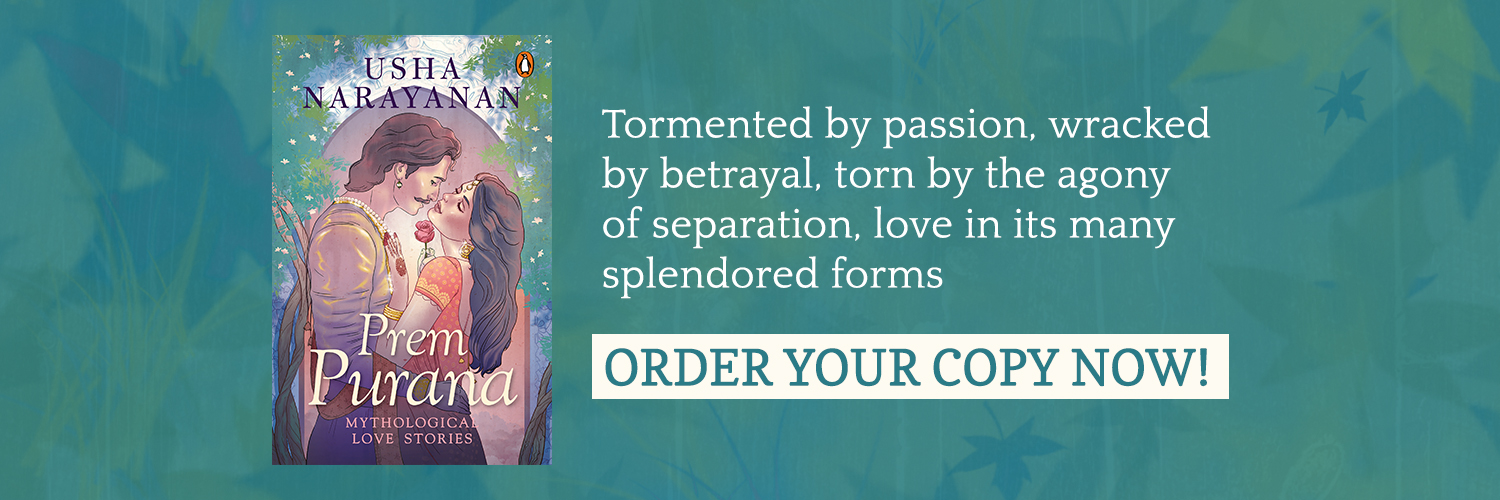
Just Before We Set Off For Earth — 'Earthward Bound'
As one recovers from the heavy hearts left behind after a brilliant week of Durga Puja fun and festivities, here’s a little throwback with a short story, ‘Earthward Bound’, by writer Nayanika Mahtani, on what happens in Goddess Durga’s household just before she descends on earth with her children, ushering in a joyful autumn!
‘Come on kids, get ready – we’re off on a little journey,’ said Goddess Durga. Her four children Lakshmi, Saraswati, Kartikeya and Ganesha were busy having a snowball fight in the mountains of Kailash.
‘Where are we headed, Ma?’ asked Ganesha.
‘To Earth of course, silly!’ said Saraswati.
‘Have you forgotten – we go every year when Ma is invited by her devotees?’ said Lakshmi.
‘I knew that – obvio!’ mumbled Ganesha.
‘Yup, he would never forget the sweets at Puja,’ piped in Kartikeya.
‘Could you four please stop squabbling – we need to get there in time!’ said Ma Durga. ‘Oh, quick check – have I taken everything?’
‘Hmm, let’s see Ma,’ said Saraswati. ‘Have you got Vishnu’s discus, Shiva’s trident, Varuna’s conch and noose, Agni’s flaming dart, Vayu’s bow, Surya’s quiver full of arrows, Yama’s sword and shield, Vishwakarma’s axe and armour and Indra’s thunderbolt?’
‘Whoa! That’s quite a handful – good thing you have so many hands, Ma!’ said Ganesha. ‘How come you get to keep all the weapons that the Gods gave you to fight Mahishasur – even though he is now long dead?’
‘Well, Mahishasur may be dead but evil lives on, Ganesha – and I always need to be ready to fight evil,’ replied Ma Durga.
‘Will we be riding on the lion given to you by Himavat?’ asked Lakshmi.
‘Of course!’ said Ma Durga. ‘Now as you know the Devi Paksha rituals start from Mahalaya, when we begin our journey to Earth. Who remembers what Mahalaya means?’
‘Ahem, I do!’ said Kartikeya, casting a sideways glance at Ganesha. ‘“Maha” means ‘big’, and “laya”, means ‘destruction’. It refers to the colossal war between the Devtas, Rishis and Asuras – where many Devtas and Rishis died at the hands of the Asuras. People on Earth consider Devtas and Rishis to be their forefathers. That’s why the ritual of Tarpan or Shraddh happens on Mahalaya, when prayers are offered in remembrance.’
‘Bah! Such a show-off!’ muttered Ganesha, whose mind was now feasting on the soon-to-be-had sandesh and laddoos.
‘Though the actual Puja starts from the sixth day, the Shashthi, when we five arrive on Earth,’ added Saraswati.
‘That’s right,’ said Ma Durga. ‘It begins with Bodhan, which marks the moment when I was given all the divine arms to rid the Earth of Mahishasur’s tyranny. On Shashti, my face is uncovered – to show that I have arrived on Earth. The next day is Saptami and it starts with a ritual called “Kola Bou”.’
“Ha ha! Kola Bou’s your wife, Ganesha!’ teased Lakshmi. ‘Such a pretty banana tree stalk, bathed and draped in a white sari with a red border and placed by your side!’
‘Tsk, don’t make him blush, Lakshmi!’ chided Ma Durga. ‘Actually it is not just a banana stalk that is bathed; nine plants are placed by my Ganesha after the bathing rituals. It’s called “Nabapatrika” puja – and these nine plants represent the nine forms of Shakti, of which you are one too, my Lakshmi.’
‘I feel a bit sidelined, to be honest,’ said Saraswati.
‘Come on! You get a day all to yourself to be worshipped,’ said Kartikeya.
‘Well, you get a day like that too, Kartikeya’ said Ma Durga. ‘Anyway, let’s not get sidetracked, kids! So then follows Ashtami which is considered the most auspicious day of Durga Puja – with its most significant ritual being the Sandhi Puja.’
‘Let me elaborate,’ said Kartikeya with a flourish. ‘Sandhikshan, when Sandhi Puja is done, falls between the last 24 minutes of Ashtami and the first 24 minutes of Navami. This is the exact time when the Asuras Chanda and Munda were slain by Ma.’
‘It for this reason I am also called Chamunda,’ said Ma Durga.
‘Aarrgh! Why doesn’t our family keep just one name for each of us?’ asked Ganesha. ‘I have such a hard time keeping track of all my names. It’s so tricky figuring out when I’m being called!’
Ma Durga smiled and carried on. ‘Then comes Dashami or Vijaya Dashami which is the day I killed Mahishasura – and freed the Earth of his torments. Vijaya Dashami is the last day of the puja.’
‘And it’s also when Ma’s idol is taken to a water body and immersed, denoting her journey back to Kailash,’ said Saraswati.
‘That’s right! Well done, all of you!’ said Ma Durga. ‘Now hold on tight – we’re about to take off!’
‘Have a safe journey, family,’ boomed a deep voice in the background. He watched Ma Durga and the children fly earthwards. Lord Shiva closed his eyes. ‘Ah! Now for some peace and quiet, finally.’
Would you like to look up what each of the weapons of Goddess Durga signifies? Hindu mythology is such a treasure trove – there’s always more than what meets the eye. Look for these treasures – you won’t be disappointed!
Note: Ganesha was of course just pretending to not know all the answers in this story, to rile his Mum and siblings. He in fact is quite the know-it-all. Though he can get distracted when sweets are involved. ☺
Nayanika Mahtani is a copywriter by day and a storyteller by night. She lives in London with her husband, two daughters and their two goldfish named Sushi and Fishfinger. Nayanika has published two books with Puffin, ‘Ambushed’ and ‘The Gory Story of Genghis Khan’.
The Great Animal Kingdom of Hindu Mythology: ‘Pashu’ — An Excerpt
Hindu mythology not only has some of the most interesting human characters ever, but a huge kingdom of animals too. From fish that save the world to horses that fly higher than birds, every animal in Hindu mythology has a story to tell and a lesson to teach.
Devdutt Pattanaik’s ‘Pashu’ dives into this bizarre, wonderful world of mythological animals and unravels a secret or two about it.
Here’s a snippet from ‘Pashu’ that is sure to make you want to find out more!
Brahma, the creator, had a son called Kashyapa. Kashyapa had many wives who bore him different types of children. Aditi gave birth to the devas—gods who live in the sky. Diti gave birth to the asuras— demons who live under the earth. Kadru gave birth to the nagas, slithering serpents and worms that crawl on trees and on earth. Vinata gave birth to garudas, birds and insects that fly in the air. Sarama gave birth to all the wild creatures with claws and Surabhi gave birth to all the gentle animals with hooves. Timi gave birth to all the fishes and Surasa gave birth to monsters. Thus, all gods, demons, animals and even humans have a common ancestor in Kashyapa. They call him Prajapati, father of all creatures. His story is found in the Puranas, books that are at least two thousand years old.
There are also other theories of how animals came into being. Some can be found in earlier books, while some have never been written but passed down orally by stargazers and storytellers.
Brahma and Shatarupa: The first man, Brahma, saw the first woman, Shatarupa, and fell in love with her. He tried to touch her. She laughed and ran away. He followed her. To avoid getting caught, she turned into a doe. To catch up with her, he turned into a stag. She then became a mare. He became a stallion. She transformed into a cow. He turned into a bull. She became a goose and flew up into the air. He followed her, taking the form of a gander. Every time she took a female form, he took the corresponding male form. This went on for millions of years. Thus, over time, all kinds of beasts came into being, from ants and elephants to dogs and cats. So say the Upanishads, conversations that took place nearly three thousand years ago.
Yogasanas: Shiva, the great yogi, was at peace with himself. In his joy, he assumed many poses, known as asanas. Many of these poses resembled animals. For example, the ustra-asana resembled a camel. When Shiva took this pose, camels came into being. From the matsya-asana, fishes came into being. From the bhujang-asana, snakes came into being. From the salabh-asana, locusts came into being. From the go-mukha-asana, cows came into being. Shiva thus stood in millions of poses, giving rise to millions of different kinds of animals. So says the lore of yogis.
Avatars: From time to time, Vishnu, who resides on the ocean of milk, descends to walk on the earth. He takes the form, or avatar, of different animals when he does so. Sometimes he is a fish, sometimes a turtle, sometimes a wild boar, sometimes a swan . . . In memory of the many forms he took, various animals came into being. So the next time you see a fish, remember that it was once a form of Vishnu. And when you see a swan, remember that, too, was once a form of Vishnu.
Rashi: A cluster of stars is known as a constellation. Ancient rishis divided the sky into twelve equal parts, each occupied by a constellation. The constellations are called zodiacs in English and rashis in Sanskrit. Some of the rashis take the form of animals. There is the Mesha or ram constellation that the sun passes through in early summer. Then there is Mina, the fish; Vrishchika, the scorpion; Simha, the lion; and Vrishabha, the bull. After the sun passes the Makara constellation, whose tail is like a fish and head is like an elephant, the days grow longer and warmer, heralding the approach of summer. After the sun passes the Karka or crab constellation, the days become shorter and colder, indicating the approach of winter. This information comes from Jyotisha Shastra, or the books of astrology. Poets often wonder what came first: the constellations or the animals. Did the design of the stars inspire the gods to create the animals?
Yoni: Many Hindus believe that a being gets a human life only after passing through 84,00,000 animal wombs. Astrologers say that one can find out which was the last animal’s womb or yoni one was born in from one’s time of birth. That yoni determines an aspect of one’s personality. Some of the yonis are: elephant, cow, mare, snake, cat, dog, rat, monkey, tiger, goat, buffalo and deer. Which yoni came first—that of man or that of an animal? Are humans the ancestors of animals or is it the other way around? There is no escaping the fact that we are related to the birds and beasts of the forest. They may be our ancestors or they may be our descendants.
Have more questions on the origins of the mythological animal kingdom? Get your copy of ‘Pashu’ now!









